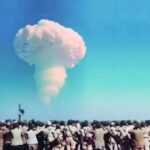Existential threats, fast and slow
By Kennette Benedict | July 18, 2013
In the past month US President Barack Obama has focused the world’s attention on two threats that may not, at first glance, appear to have much in common. On June 19th he spoke at Berlin’s Brandenburg Gate, delivering a major statement about nuclear weapons policy. A week later he was at Georgetown University, where he made a long-awaited speech on climate change.
What do these have to do with each other? A single nuclear warhead can kill thousands of people in an instant. Climate change is causing damage much more slowly, and to the naked eye, it’s hard to see the link between greenhouse gases and rising sea levels, extreme weather events, and shrinking food supplies. But despite the differences, nuclear weapons and climate change have a great deal in common. That is why the Bulletin of the Atomic Scientists, which created the Doomsday Clock in 1947 to graphically represent how close humans are to self-destruction, decided six years ago to include climate scientists in its deliberations on where to set the minute hand. It was a controversial decision at the time, one we are still called on sometimes to justify.
Man-made problems.First of all, both threats are of humans’ own making. The atomic bomb was invented by the Allies during World War II out of fear that Nazi Germany might develop one first. The fission process was well known in scientific circles by the early 1940s, and it was only a matter of time before someone would figure out how to use nuclear energy for a bomb. However, scientific knowledge ran ahead of the ability to prevent arms races and securely manage this most dangerous technology. By 1986, the Soviet Union and the United States together possessed nearly 70,000 nuclear bombs — enough to destroy the world and its inhabitants many times over. Even more alarmingly, the Soviets and Americans followed deployment rules that required nuclear-armed missiles to be launched in a matter of minutes without warning the other side.
Scientific knowledge about the effects of carbon dioxide and methane emissions on the Earth’s atmosphere began to accumulate in the 1950s. The coal, gas, and oil-fired machines that have powered massive economic growth emit these gases, while at the same time humans are destroying forests that absorb carbon dioxide. Together these phenomena have combined to warm the Earth’s atmosphere. This warming is bringing about such vast changes to our agricultural yields, fisheries, and habitats that we may not be able to adapt fast enough as a species to survive. Despite the warnings of science, we seem unable, so far, to adopt new technologies and fuels that would reduce the harm we’re bringing upon ourselves.
Dangerous complacency. Second, neither nuclear weapons nor climate change are treated with appropriate sustained concern. In his Berlin speech, President Obama observed that “there can, at times, be a complacency among our Western democracies” about both threats.
When it comes to nuclear weapons, complacency is the child of secrecy and ignorance. The number of warheads a country has and the military’s plans to use them are state secrets, and theories of deterrence that provide a rationale for their use are cloaked in technical jargon that induces boredom in most people. As a result, nuclear weapons policy discussion takes place beyond the public eye and outside of the democratic decision-making process.
In contrast, there is nothing secret about climate change. Scientists have been observing, documenting, and speaking about changes to the atmosphere and oceans brought about by carbon dioxide and methane emissions for at least half a century. But the dangerous effects of changes in the Earth’s temperature are felt slowly, and often only as the cycles of extreme weather become part of our common experience. With each hurricane, violent storm, drought, or massive wildfire, the public’s awareness of the effects of global warming rises, only to subside into complacency once the immediate danger has passed.
Acting together.Third, both of these threats to human society require a cooperative response by governments. “Our shared past shows that none of these challenges can be met unless we see ourselves as part of something bigger than our own experience,” Obama said in Berlin.
Because no country is safe from destruction by nuclear bombs, every country that possesses them has some incentive to dismantle them. Overcoming the perceived need to hang on to them for political advantage, though, will be an enormous challenge. A world free of nuclear weapons can only be achieved by simultaneous and cooperative action.
Cooperation will also be required to cut greenhouse gas emissions. Robust economic incentives for companies to do so — either by modifying technology or finding alternative fuels — do not currently exist. Market forces work well to distribute goods and services efficiently, but they are not working as well to shift industry to new energy technologies. The challenge here is that countries do not want to lose out economically in the short run by cutting emissions first. For the common good of protecting our planetary home, governments and firms need to act collectively.
The Bulletin and the Doomsday Clock. In 1945 the scientists who created the atomic bomb launched the Bulletin of the Atomic Scientists to warn the public of this terrifying new man-made threat; two years later the Bulletin created the Doomsday Clock, a simple design portraying the last quadrant of an abstract clock with its minute hand nearing midnight. When it is warranted, Bulletin experts reset the Clock based on an assessment of the threats to humanity from nuclear and other Earth-threatening technologies.
In 2007, the Bulletin invited climate scientists to join the discussions. Like the early nuclear physicists, these scientists understand the threats to humanity from our own inventions. Without the horror of explosions and instant mass death, the dire consequences of climate change are not as easy to detect as those of nuclear weapons. But if we are to have any chance of slowing the rate of calamitous change, then we have to act now.
When the Bulletin moved the Clock’s minute hand from seven to three minutes to midnight in 1949, after the Soviet Union tested its first atomic bomb, the United States possessed 170 bombs and the Soviet Union just one (not including the one it tested). Long-range missiles to carry miniaturized nuclear weapons across the Atlantic had not yet been developed, and the possibility of a nuclear Armageddon was still several years away. The world was not about to blow up. But the ticking Clock alerted the public to the prospect of an arms race between the United States and the Soviet Union if political leaders did not reduce tensions and stop the production of nuclear weapons. Without international agreements to prevent the use of these weapons, the scientists warned, the world would be doomed.
Today, climate scientists are in a position similar to that of the early atomic scientists. Just as the Manhattan Project participants could foresee the coming arms race, climate scientists today understand the consequences of deploying the technologies that defined the industrial age. They also know that action now to reduce greenhouse gas emissions will mitigate the worst consequences of climate change, just as the Manhattan Project scientists knew that early action to forestall a deadly arms race could prevent nuclear catastrophe. In both cases, the Clock represents a judgment about the capabilities of the world’s governments, civic leaders, and citizens to tackle the catastrophic global consequences of human inventions.
Whether societies develop the means to control dangerous technologies before they destroy our way of life remains to be seen. It is clear, however, that if the complacency about global threats that Obama recently noted continues, our chances of surviving diminish. From the beginning, the Doomsday Clock has drawn attention to the dangers we face not only from our inventions, but from ignorance and short-term thinking. We ignore it at our peril.
Together, we make the world safer.
The Bulletin elevates expert voices above the noise. But as an independent nonprofit organization, our operations depend on the support of readers like you. Help us continue to deliver quality journalism that holds leaders accountable. Your support of our work at any level is important. In return, we promise our coverage will be understandable, influential, vigilant, solution-oriented, and fair-minded. Together we can make a difference.
Topics: Climate Change, Columnists, Nuclear Weapons















